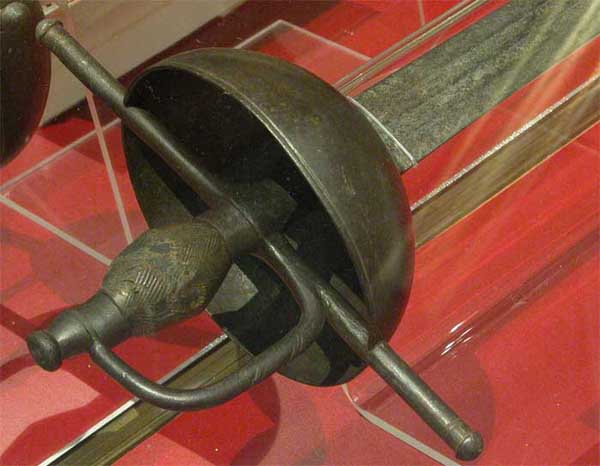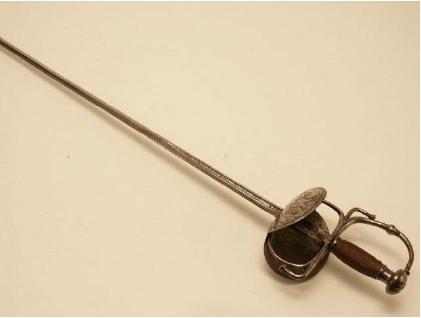I posted a question about this on SFI but thought I ask here too in order to get as much info as possible. I'm confused about the age of this piece and these swords in general - don't even know how to spell it properly! Hope you folks can educate me.
I just bought this a few days ago and know I was taking a chance but, again, I couldn’t help myself. What I at first thought was a Spanish rapier of some sort, I now believe to be a Bilboa/Bilbao/Bilbo sword (don’t know what the proper spelling is). I contacted a man who is extremely well versed in medieval combat and has handled hundreds of period weapons and from seeing these very poor initial pics (I’ll post more when I have the weapon in hand) he dubbed it a 16th century Bilboa.
I’d like to know if anyone can add anything to this appraisal or even just give me more information about this weapon and its history. I’ve spent days trying to research it on the web but have gotten practically nowhere! I know it’s hard to tell from these pics but hopefully they are enough to start with. I should the piece this week sometime. Thanks!
[ Linked Image ]
[ Linked Image ]
[ Linked Image ]
Hello
Is the first time for me to write, please let me know if this information is useful. Bilbao is a city in the northern coast of Spain, in the center of the Basq Country. Bilbo is the spelling of that name in Basq language. Bilboa, I have never heard of.
I don't know of any autochthonous sword from that city but the area was a popular recruiting ground for the Spanish tercios in the 17th century
I hope this helps
Is the first time for me to write, please let me know if this information is useful. Bilbao is a city in the northern coast of Spain, in the center of the Basq Country. Bilbo is the spelling of that name in Basq language. Bilboa, I have never heard of.
I don't know of any autochthonous sword from that city but the area was a popular recruiting ground for the Spanish tercios in the 17th century
I hope this helps
The name taken from the city ( I do not know why) describes a family of Spanish military swords in use since about the 17th century until the middle of the 19th century. The hilt usually has a somewhat cuplike guard made up of plate that is shaped a bit like a lozenge on either side of the blade ( picture a very large small sword guard shallowly dished) with long straight quillons and a single knucklebow running from the guard to the pommel. The blades are normally of straight military cut and thrust from. Theres one on the cover of "Swords and Hilt Weapons". What you have here seems to more of a cup hilt in a form i've usually heard refered to as "Carlos the III" or "Carlos the V" style ( i'm not sure about the history of the attributation). These vary from the more traditional cup hilts often associated with piracy and ocean warfare in the Carribean in the 17th century in that the quillons tend to be of S form and the cup rather than being just a simple dish has and extension on the right ( knuckle or outside of the fist when grasping and using a sword in the right hand) side of the cup running back to the pommel. Your sword seems to be of this type which would put it most likely in the area of the 17th century based on the little bit I knwo about them. Maybe some one with a better knowledge base can provide more info for you.
Sorry for the back to back posts, some close ups of the hilt/guard, blade any inscriptions on either ect. would help in determmining the authenticity of the item.
This is the style I think of as a "Bilbo" hilt. This one is late 18th c.
 Attachment: 72.44 KB
Attachment: 72.44 KB


Sean, i've always heard these refered to as cup hilts and often in arms and armour auction catalogs as Carribean cup hilts ( appearently alot of these were made locally in the Carribean using imported blades but locally made hilts). Theres one pictured in the "Rapier and Rapier Hilted Swords"album. The bilbo as i've seen it mentioned could use the same cut and thrust military blade on the sword you have shown but the plate of the guard is shallower and is shaped like a very large version of the plates on a Pappenheimer sword( only made from a single plate), usually without piercework and no bars save the knuckle bow and the qullions. Of course with the tendency to use different phrases for the same weapon/armour it quite possible that both names were used for the same sword.
Here is a picture from Higgins Armory Museum of a bilbo in their collection. This piece is dated to 1st half of the 17th century. In case it is helpful, here is the description from their catalog:
I marked in bold a part of the description that jives with Allan's comment.
 Attachment: 7.08 KB
Attachment: 7.08 KB

HAM 671
| Higgins Armory Museum wrote: |
| Steel double edge flattened hexagonal section wide blade tapering gently to spatulate point. Hollow-ground on both forte faces. Obverse face stamped "xx ENx RLQUE xGOEL x"; reverse "xxx EN x ALAMANIA x" (for 'Heinrich Kökl or Coel). Both terminating with anchor-like cross mark at end. Aysmmetrical bivalve iron shell bent toward guard, screwed to butterfly-shaped base plate of large arms of the hilt at short ricasso. Crossguard recurved in plane of blade with balustered teminals. Curved knuckle guard balustered at mid-height with similar terminal. Swollen pommel tapering to stout base. Wooden grip wrapped in braided brass wire & reinforced by iron strips on faces. |
I marked in bold a part of the description that jives with Allan's comment.

HAM 671
Here is another item from the Higgins Armory Museum, but they call this one a "Bilbo-Hilted Rapier". This catalog description also refers to the guard as having
The hilt construction is a little clearer in this picture.
 Attachment: 10.41 KB
Attachment: 10.41 KB

HAM 1803.1
| Higgins Armory Museum wrote: |
| ... asymmetrical bivalve shell bent towards hilt ... |
The hilt construction is a little clearer in this picture.

HAM 1803.1
Thanks guys! This is all great info and will bring us closer to a correct ID for this piece. I feel that with the more precise an identification hat I can have, the better a custodian I can be of this sword. I hope to be able to give you all better pictures tomorrow or the next day since I believe I'll have it in hand. Until then I thank you all for your help and hope to see more pictures of similar swords and perhaps more information on the “Carlos” types that Allen mentioned. Thanks again and I hope to hear from more experts on these (to me at least) mysterious swords.
Finally have this sword in hand. I'm not sure what to think as I've never handled a true antique sword before. Somehow it doesn't seem to be "tough" enough to be a real fighting weapon. And, I'm sorry to say, there are no markings whatsoever on the blade. Anyway here are the new pics - maybe by seeing these someone can help in more acurately identifying this sword and hopefully dating it.
[ Linked Image ]
[ Linked Image ]
[ Linked Image ]
[ Linked Image ]
[ Linked Image ]
[ Linked Image ]
[ Linked Image ]
[ Linked Image ]
[ Linked Image ]
[ Linked Image ]
Hope these help, Thanks.
[ Linked Image ]
[ Linked Image ]
[ Linked Image ]
[ Linked Image ]
[ Linked Image ]
[ Linked Image ]
[ Linked Image ]
[ Linked Image ]
[ Linked Image ]
[ Linked Image ]
Hope these help, Thanks.
Uh Oh.
Someone more versed could tell you better, but I don't believe that those twin screws on the hilt are meant to be there. I think it's even more iffy that it appears that a modern screwdriver could take them out.
Someone more versed could tell you better, but I don't believe that those twin screws on the hilt are meant to be there. I think it's even more iffy that it appears that a modern screwdriver could take them out.
| Grayson C. wrote: |
| Someone more versed could tell you better, but I don't believe that those twin screws on the hilt are meant to be there. I think it's even more iffy that it appears that a modern screwdriver could take them out. |
I've no comment on if the screws, themselves, are original, but the feature of having screws there is not uncommon. I do know that slotted screws are quite an old invention, as well.
| Grayson C. wrote: |
| Uh Oh.
Someone more versed could tell you better, but I don't believe that those twin screws on the hilt are meant to be there. I think it's even more iffy that it appears that a modern screwdriver could take them out. |
I've seen that type of hilt construction on 16th century swords and later. It's very common.
| Grayson C. wrote: |
| Uh Oh.
Someone more versed could tell you better, but I don't believe that those twin screws on the hilt are meant to be there. I think it's even more iffy that it appears that a modern screwdriver could take them out. |
I am not qualified to comment on the authenticity of Tim V's new sword, but, the Higgins Armory Museum bilbos, pictures of which I posted a little earlier in this thread, each had the guards secured to the hilt with screws.
I agree with Bill and Steve regarding the screws, a mortuary sword's hilt comes to mind as an example of screws of this type. I do wonder however about the crude way the whole sword is put together. It just seems kind of sloppy in some way - hard to put my finger on it exactly. Maybe someone else has some thoughts they'd be kind enough to share?
Page 1 of 1
You cannot post new topics in this forumYou cannot reply to topics in this forum
You cannot edit your posts in this forum
You cannot delete your posts in this forum
You cannot vote in polls in this forum
You cannot attach files in this forum
You can download files in this forum
All contents © Copyright 2003-2006 myArmoury.com — All rights reserved
Discussion forums powered by phpBB © The phpBB Group
Switch to the Full-featured Version of the forum
Discussion forums powered by phpBB © The phpBB Group
Switch to the Full-featured Version of the forum